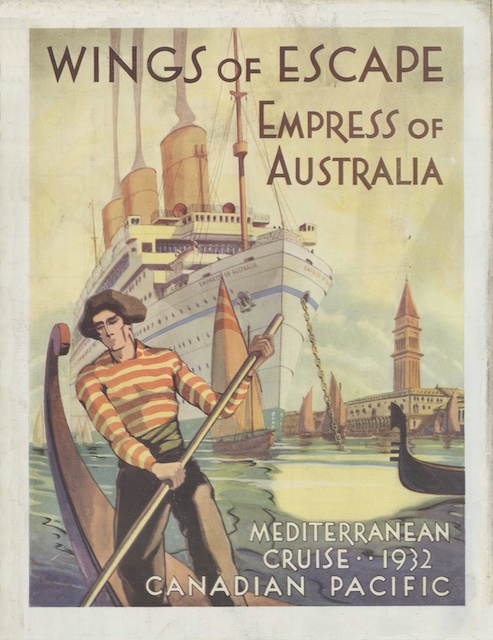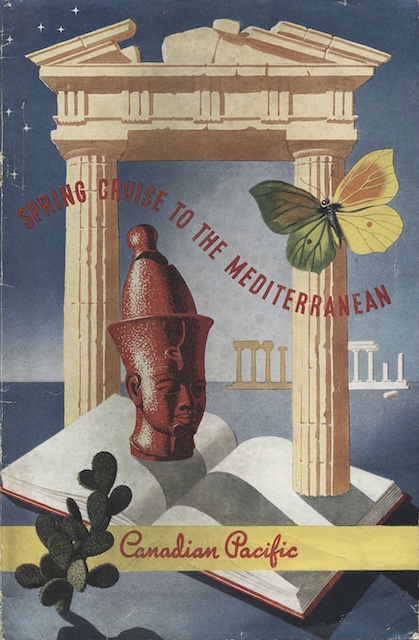Unlike the booklets advertising the world cruises, the 1930s West Indies cruise booklets we’ve seen didn’t have lavish paintings on their covers. However, the Mediterranean cruise booklets are more impressive. This may be because the West Indies cruises were short, 28 days or less, while many of the Mediterranean cruises were 66 days or longer, and perhaps Canadian Pacific thought they needed or deserved more attention.
 Click image to view and download a 71.9-MB PDF of this booklet from the Chung collection.
Click image to view and download a 71.9-MB PDF of this booklet from the Chung collection.
The 1932 booklet, for example, has a beautiful color painting of what appears to be Cadiz, Spain, which was the third port visited by the cruise. The painting is signed G.S. Bailey, which means Geoffrey Spinks Bailey (1901-1992), an English artist who moved to Canada in 1929, where he made posters and other illustrations as well as war-related paintings during World War II. He returned to England after the war and settled in Rye.
Inside this booklet are dozens of black-and-white photos of the Empress of Australia (which, the booklet notes, was Canadian Pacific’s “former world cruise ship”) along with more than three dozen water color paintings showing destinations along the cruise. The water colors are signed “AC,” which I suspect means Alfred Crocker Leighton (1901-1965), who signed his full-sized paintings “A.C. Leighton.” Leighton was born in Hastings, England and learned to paint at the Hastings School of Art. In 1924, the Canadian Pacific public relations office hired him to paint scenes along the railway as well as make several posters. I can’t find any evidence that he took a Mediterranean cruise, but I don’t know of any other ACs who could have made these water colors.
The cruise started in New York on February and ended in Southampton on April 8. The fares, which started at $900 (about $20,000 today), included a return from Europe or England to New York on any Canadian Pacific ship. Since most CP ships went to Halifax or Montreal, the fare also included first-class rail fare (but not a berth) from Canada to New York City.
 Click image to view and download a 13.4-MB PDF of this brochure from the Chung collection.
Click image to view and download a 13.4-MB PDF of this brochure from the Chung collection.
This colorful brochure has detailed deck plans of the Empress Australia but no fare information. The cover painting isn’t signed.
 Click image to view and download a 64.4-MB PDF of this brochure from the Chung collection.
Click image to view and download a 64.4-MB PDF of this brochure from the Chung collection.
The 1933 booklet advertising the Mediterranean cruise has another wraparound cover, but unfortunately it isn’t signed. Inside, the water colors have been replaced by monochromatic drawings, perhaps a sign of the Depression.
 Click image to view and download a 13.9-MB PDF of this brochure from the Chung collection.
Click image to view and download a 13.9-MB PDF of this brochure from the Chung collection.
Another sign of the Depression was a dramatic drop in fares. Where the 1932 cruise was advertised with a base fare of $900, the 1933 cruise had fares as low as $560 (about $13,000 today). Rooms with baths cost a minimum of $950 per person ($22,000 today), and there were only two at that price; the rest were $1,150 to $1,250 ($26,000 to $28,000 today).
 Click image to view and download a 32.3-MB PDF of this brochure from the Chung collection.
Click image to view and download a 32.3-MB PDF of this brochure from the Chung collection.
The unsigned cover painting on the 1934 booklet is not quite as elaborate as the previous two. While there is a similarly styled painting on the back, they don’t match features and so it isn’t a wraparound painting. Inside is entirely black-and-white except for some gold trim.
 Click image to view and download a 9.2-MB PDF of this brochure from the Chung collection.
Click image to view and download a 9.2-MB PDF of this brochure from the Chung collection.
The Chung collection doesn’t have much from the 1935 through 1938 cruises, but it does have this booklet advertising a 1939 cruise that started and ended in Southampton. The cruise was just 31 days long, from March 3 through April 3, stopping at fewer than half as many ports as the 1932-1934 cruises from New York.
This cruise was aboard the Empress of Australia, which means that a longer cruise from New York probably didn’t take place that year. In previous years, including 1933 and 1934, CP had operated two-week Mediterranean cruises out of Southampton or other English ports that stopped in just four ports.
